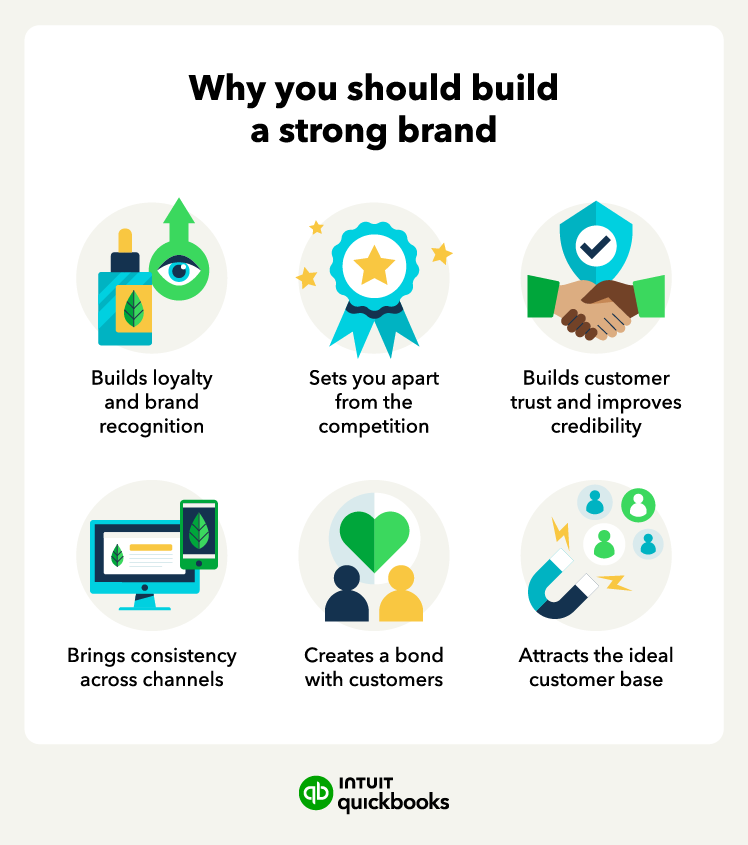Discover the secrets to creating a powerful brand identity that sets your business apart from the competition and captivates customers.

Image courtesy of via DALL-E 3
Table of Contents
Introduction to Brand Identity
Brand identity is like having a special stamp that makes a company or a product stand out. Think of it like when you see your favorite superhero on TV – you know right away who they are just by looking at them. In the same way, a strong brand identity helps people recognize and remember a business or a product easily.
What is a Brand?
When we talk about a brand, we’re talking about the name, logo, colors, and the feeling people get when they see or hear about a company or a product. For example, when you see a big yellow M, you might think of a place where you can get yummy fries and burgers. That’s the power of a brand – it helps you remember and choose your favorites.
Why is Brand Identity Important?
Businesses need to have a strong brand so that people can trust them and remember them. Just like how you trust your best friend and can recognize them in a crowd, businesses want customers to feel the same way about them. Having a strong brand helps businesses to stand out and build a good relationship with their customers.
Elements of a Brand Identity
A logo is like a special picture that represents a brand. Think of it as a superhero’s symbol that everyone recognizes. For example, when you see the golden arches, you know it’s McDonald’s. Logos help people remember and trust a brand. They are like a unique stamp that makes a brand stand out.
Color Scheme
Colors play a big role in creating a brand identity. Imagine if your favorite chocolate bar suddenly changed its wrapper color; you might not recognize it! Colors can evoke certain feelings and emotions, so they are carefully chosen to represent a brand. For instance, red can make you feel excited, while blue can make you feel calm.
Font
A font is like the style of writing that a brand uses. Just like you have your own handwriting, brands have their fonts. Fonts help to showcase the personality of a brand, whether it’s fun and playful or serious and professional. For example, a fancy cursive font might be used for a brand that wants to show elegance.
Tagline
A tagline is a short and catchy phrase that sums up what a brand is all about. It’s like a mini description that sticks in people’s minds. For instance, Nike’s tagline “Just Do It” encourages you to take action and be brave. Taglines help to communicate the message and values of a brand.
Creating a Brand Identity
Research
Before you can start creating your brand identity, it’s important to do some research. This means looking at what other businesses in your market are doing and seeing what works well. By understanding what your competitors are doing, you can figure out how to make your brand stand out.
Define Your Brand
Once you’ve done your research, it’s time to figure out what you want your brand to represent. Think about what makes your business unique and what values you want to communicate. Whether it’s quality, creativity, or fun, defining your brand’s essence will help guide all your branding decisions.
Design Your Logo
Your logo is a crucial part of your brand identity. It’s the visual representation of your business and what people will remember you by. Take some time to sketch out different ideas for your logo, thinking about how it reflects your brand’s values and personality.
Choose Colors and Fonts
Colors and fonts play a big role in creating a memorable brand identity. Think about what emotions you want your brand to evoke and choose colors that match. Different colors can convey different meanings, so pick ones that align with your brand’s message. Similarly, choose fonts that are easy to read and reflect the tone of your brand.
Communicating Your Brand
In order to make sure that people know about your brand and what it stands for, you need to communicate it effectively. This means sharing your brand message with others in a way that is clear and consistent.

Image courtesy of quickbooks.intuit.com via Google Images
Social Media
Social media is a powerful tool that can help you share your brand with a wide audience. You can use platforms like Facebook, Instagram, and Twitter to post about your products or services, engage with your customers, and show off what makes your brand unique. By creating interesting and engaging content, you can attract new customers and build a loyal following.
Advertising
Advertising is another way to communicate your brand to potential customers. You can use methods like TV commercials, online ads, or even billboards to reach a larger audience. Make sure your advertising is consistent with your brand identity, using the same colors, fonts, and messaging to reinforce who you are as a company.
Maintaining Brand Consistency
In the world of branding, consistency is key. Brand consistency means making sure that no matter where people interact with your brand, whether it’s on social media, in print, or in person, they always get the same message and feel the same way about your brand. Let’s dive into why maintaining brand consistency is crucial for businesses.
Brand Guidelines
One way to keep your brand on track is by creating brand guidelines. These guidelines are like a rulebook for your brand, laying out things like your logo usage, colors, fonts, and even the tone of voice you use in your messaging. By following these guidelines, you ensure that every piece of content you put out there reflects your brand accurately and consistently.
Regular Updates
Another essential aspect of maintaining brand consistency is keeping things fresh and up-to-date. Just like how you wouldn’t want to wear the same outfit every day, your brand also needs a little refresh now and then. Whether it’s updating your logo to a more modern design or revamping your website to better reflect your brand, regular updates help keep your brand relevant and in line with your target audience’s preferences.
Tracking Brand Success
Monitoring the success of your brand is crucial to ensure that your efforts are paying off and that your brand is resonating with your target audience. By tracking various indicators, you can make informed decisions to strengthen your brand presence further. Here are some strategies to help you keep track of how well your brand is doing:
Customer Feedback
One valuable way to gauge the success of your brand is by listening to your customers. Ask for feedback through surveys, reviews, or social media interactions. Understanding what your customers like and dislike about your brand can help you make improvements and tailor your offerings to better meet their needs. Remember, happy customers are more likely to become loyal advocates for your brand.
Sales and Metrics
Sales and metrics provide concrete data on the performance of your brand. By analyzing sales figures, website traffic, social media engagement, and other key performance indicators (KPIs), you can measure the impact of your brand-building efforts. Keep track of these metrics regularly to identify trends and areas for improvement. Remember, the goal is to see positive growth and engagement from your target audience.
Revamping Your Brand
In the world of business, sometimes brands need a makeover to stay fresh and exciting. Let’s explore why and how a brand might need to be revamped or completely rebranded.

Image courtesy of www.visme.co via Google Images
When to Rebrand
There are signs that indicate when it might be time to refresh your brand. If your brand no longer reflects your values or resonates with your target audience, it could be time for a change. Maybe your business has evolved, or your competitors have raised the bar, and your brand needs to catch up. Take a look at your brand and see if it still aligns with your goals and speaks to your customers.
Steps to Rebrand
When you’ve determined that it’s time for a change, here are some simple steps to kickstart the rebranding process:
1. Reflect on your brand’s history and what you want to achieve with the rebrand.
2. Research your target audience to understand their preferences and needs.
3. Define your new brand identity, including elements like logo, color scheme, and messaging.
4. Design a new logo that captures the essence of your brand’s new direction.
5. Choose colors and fonts that reflect the personality of your revamped brand.
6. Update all brand elements across platforms, including your website and social media profiles.
7. Communicate the changes to your audience and explain the reasons behind the rebrand.
Remember, rebranding is an opportunity to breathe new life into your brand and connect with your audience in a fresh way. Embrace the process and watch your brand evolve into something even more remarkable.
Examples of Strong Brand Identities
Apple is a great example of a company with a strong brand identity. The Apple logo, a simple, sleek apple silhouette, is instantly recognizable around the world. The company’s products are known for their high quality, innovative designs, and user-friendly interfaces. Apple’s consistent use of white and silver colors in its packaging and marketing materials also contributes to its strong brand identity. Overall, Apple’s brand is associated with cutting-edge technology, creativity, and elegance.
Disney
Disney is another brand that has built a strong and magical identity. The Disney logo, with its iconic cursive font and whimsical castle, immediately evokes feelings of nostalgia and wonder. Disney’s brand is all about storytelling, imagination, and creating happy memories. The company’s use of vibrant colors, beloved characters, and enchanting theme parks all work together to create a magical brand experience for its audience. Disney’s brand identity is deeply rooted in its commitment to creating enchanting and unforgettable moments for people of all ages.
Summary
Building a strong brand identity is essential for businesses to stand out and be memorable to customers. A brand consists of various elements like logos, color schemes, fonts, and taglines, all working together to create a unique identity. By conducting research, defining what the brand stands for, designing a logo, choosing colors and fonts, communicating effectively, maintaining consistency, tracking success, and knowing when to revamp, a brand can continuously evolve and succeed.

Image courtesy of www.infographicszone.com via Google Images
Consistency is crucial in maintaining brand health, and it’s important to keep the message and visuals in line with the brand guidelines. Regular updates keep the brand fresh and appealing to customers. By seeking customer feedback and monitoring sales and metrics, brands can gauge their success and make necessary adjustments to improve.
Examples of successful brands like Apple and Disney demonstrate how a strong brand identity can lead to consumer trust and loyalty. Apple’s sleek and modern image resonates with tech enthusiasts, while Disney’s magical brand experience captivates audiences of all ages.
In conclusion, building and maintaining a strong brand identity requires careful planning, creativity, and continuous effort. By following the steps outlined, any business or individual can create a brand that resonates with their audience and stands the test of time.
Want to turn these SEO insights into real results? Seorocket is an all-in-one AI SEO solution that uses the power of AI to analyze your competition and craft high-ranking content.
Seorocket offers a suite of powerful tools, including a Keyword Researcher to find the most profitable keywords, an AI Writer to generate unique and Google-friendly content, and an Automatic Publisher to schedule and publish your content directly to your website. Plus, you’ll get real-time performance tracking so you can see exactly what’s working and make adjustments as needed.
Stop just reading about SEO – take action with Seorocket and skyrocket your search rankings today. Sign up for a free trial and see the difference Seorocket can make for your website!
Frequently Asked Questions (FAQs)
What if I don’t have a logo?
If you don’t have a logo, don’t worry! There are other ways to create a strong brand identity. You can use a unique symbol that represents your brand or stylize your brand name in a creative way. Remember, the key is to make your brand memorable and recognizable to your audience.
How can I keep my brand fresh?
Keeping your brand fresh is important to stay relevant and attract new customers. Here are a few tips to help you keep your brand up-to-date:
- Stay updated on current trends in your industry and incorporate them into your brand strategy.
- Regularly update your content on social media and your website to keep your audience engaged.
- Listen to feedback from your customers and be willing to make changes to improve your brand.
By staying proactive and adaptable, you can ensure that your brand remains fresh and appealing to your target audience.







